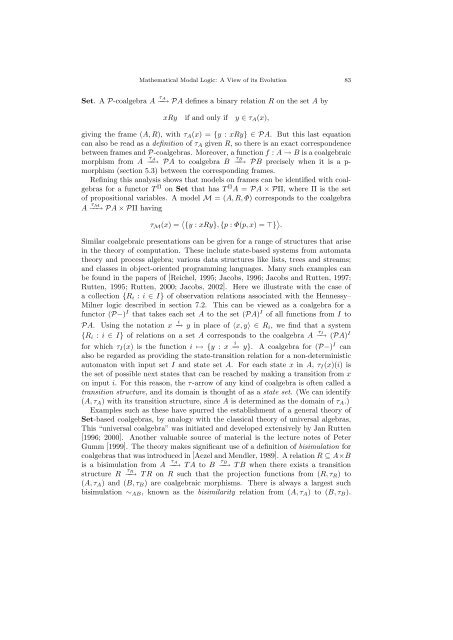MATHEMATICAL MODAL LOGIC: A VIEW OF ITS EVOLUTION
MATHEMATICAL MODAL LOGIC: A VIEW OF ITS EVOLUTION
MATHEMATICAL MODAL LOGIC: A VIEW OF ITS EVOLUTION
You also want an ePaper? Increase the reach of your titles
YUMPU automatically turns print PDFs into web optimized ePapers that Google loves.
Mathematical Modal Logic: A View of its Evolution 83Set. A P-coalgebra A τ A−→ PA defines a binary relation R on the set A byxRy if and only if y ∈ τ A (x),giving the frame (A, R), with τ A (x) = {y : xRy} ∈ PA. But this last equationcan also be read as a definition of τ A given R, so there is an exact correspondencebetween frames and P-coalgebras. Moreover, a function f : A → B is a coalgebraicτ Amorphism from A −→ PA to coalgebra B −→ PB precisely when it is a p-morphism (section 5.3) between the corresponding frames.Refining this analysis shows that models on frames can be identified with coalgebrasfor a functor T Π on Set that has T Π A = PA × PΠ, where Π is the setof propositional variables. A model M = (A, R, Φ) corresponds to the coalgebraA −−→ τ MPA × PΠ havingτ Bτ M (x) = 〈 {y : xRy}, {p : Φ(p, x) = ⊤} 〉 .Similar coalgebraic presentations can be given for a range of structures that arisein the theory of computation. These include state-based systems from automatatheory and process algebra; various data structures like lists, trees and streams;and classes in object-oriented programming languages. Many such examples canbe found in the papers of [Reichel, 1995; Jacobs, 1996; Jacobs and Rutten, 1997;Rutten, 1995; Rutten, 2000; Jacobs, 2002]. Here we illustrate with the case ofa collection {R i : i ∈ I} of observation relations associated with the Hennessy–Milner logic described in section 7.2. This can be viewed as a coalgebra for afunctor (P−) I that takes each set A to the set (PA) I of all functions from I toPA. Using the notation x −→ i y in place of 〈x, y〉 ∈ R i , we find that a system{R i : i ∈ I} of relations on a set A corresponds to the coalgebra A τ I−→ (PA) Ifor which τ I (x) is the function i ↦→ {y : x −→ i y}. A coalgebra for (P−) I canalso be regarded as providing the state-transition relation for a non-deterministicautomaton with input set I and state set A. For each state x in A, τ I (x)(i) isthe set of possible next states that can be reached by making a transition from xon input i. For this reason, the τ-arrow of any kind of coalgebra is often called atransition structure, and its domain is thought of as a state set. (We can identify(A, τ A ) with its transition structure, since A is determined as the domain of τ A .)Examples such as these have spurred the establishment of a general theory ofSet-based coalgebras, by analogy with the classical theory of universal algebras,This “universal coalgebra” was initiated and developed extensively by Jan Rutten[1996; 2000]. Another valuable source of material is the lecture notes of PeterGumm [1999]. The theory makes significant use of a definition of bisimulation forcoalgebras that was introduced in [Aczel and Mendler, 1989]. A relation R ⊆ A×Bis a bisimulation from A τ A−→ T A to Bτ B−→ T B when there exists a transitionstructure Rτ R−→ T R on R such that the projection functions from (R, τ R ) to(A, τ A ) and (B, τ B ) are coalgebraic morphisms. There is always a largest suchbisimulation ∼ AB , known as the bisimilarity relation from (A, τ A ) to (B, τ B ).
















